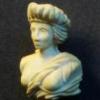-
Posts
6,358 -
Joined
-
Last visited
Reputation Activity
-
 wefalck got a reaction from Canute in Did I ruin my brush?
wefalck got a reaction from Canute in Did I ruin my brush?
There are different formulations of acrylic paints. Some only use water as 'medium', while others may have a mixture of water and some kind of alcohol. Some may also contain some sort of detergent to reduce the surface tension of water (aka as 'flow improvers'). So, the 'thinner' should be compatible with the 'medium' used in the paint formulation to prevent coagulation.
I doubt that with pure water one would be able to clean out acrylics from a brush. You need something that encapsulates the binder molecules (the acrylic resin) that otherwise have the tendency to stick to the hair of the brush (which indeed is their purpose). This is a fairly complex physico-chemical process and normally some sort of detergent ('soap') is used.
I was given a pot of 'brush soap' by my wife, but historically have used washing powder for wool. The latter is a mild detergent designed to not damage the natural animal hair (i.e. the wool).
-
 wefalck got a reaction from robert952 in Did I ruin my brush?
wefalck got a reaction from robert952 in Did I ruin my brush?
There are different formulations of acrylic paints. Some only use water as 'medium', while others may have a mixture of water and some kind of alcohol. Some may also contain some sort of detergent to reduce the surface tension of water (aka as 'flow improvers'). So, the 'thinner' should be compatible with the 'medium' used in the paint formulation to prevent coagulation.
I doubt that with pure water one would be able to clean out acrylics from a brush. You need something that encapsulates the binder molecules (the acrylic resin) that otherwise have the tendency to stick to the hair of the brush (which indeed is their purpose). This is a fairly complex physico-chemical process and normally some sort of detergent ('soap') is used.
I was given a pot of 'brush soap' by my wife, but historically have used washing powder for wool. The latter is a mild detergent designed to not damage the natural animal hair (i.e. the wool).
-
 wefalck got a reaction from FriedClams in Lula by Keith Black - FINISHED - 1:120 Scale - 1870s Sternwheeler Supply Boat for Floating Pile Driver
wefalck got a reaction from FriedClams in Lula by Keith Black - FINISHED - 1:120 Scale - 1870s Sternwheeler Supply Boat for Floating Pile Driver
... you could use black decal strips, either home-made from decal sheet or commercial ones. I am also using increasingly soft artists' felt-tip pens with pigmented acrylic paint in them for such things.
-
 wefalck got a reaction from FriedClams in Blairstown by mcb - 1:160 - PLASTIC - Steam Derrick Lighter NY Harbor
wefalck got a reaction from FriedClams in Blairstown by mcb - 1:160 - PLASTIC - Steam Derrick Lighter NY Harbor
Very intricate and detailed structure. Love these kinds of details 👍🏻
-
 wefalck got a reaction from Keith Black in La Créole 1827 by archjofo - Scale 1/48 - French corvette
wefalck got a reaction from Keith Black in La Créole 1827 by archjofo - Scale 1/48 - French corvette
I wish you a steady hand, and strong arm- and back-muscles to see you through this part of the project 👍🏻
-
 wefalck reacted to Dr PR in Did I ruin my brush?
wefalck reacted to Dr PR in Did I ruin my brush?
I found this discussion interesting. I began painting (artistic) seriously about 65 years ago. I was a student for years with artists of our local art guild. I learned from them how to care for brushes. I used oils mainly, with some watercolors and tempera. For my models I used lacquer/dope and enamel. More recently I have been using acrylics.
I have always used sable brushes with all types of paints. I have some camel hair but I don't like it. For throw-away jobs (glues, etc.) I just buy cheap whatever brushes.
Never leave brushes standing in solvents. NEVER! The liquid will wick up inside the ferrule. This causes the wood to swell, and that opens the ferrule so eventually it will fall off the handle when the brush dries.
I wash brushes with the solvent used in the paint. I have never used a detergent or soap - not even with acrylics. I wipe as much paint off as possible with paper towels. Then I dip the brush in solvent and wipe it on a paper towel. I repeat this until no pigment bleeds from the brush. Then I let the brush air dry.
Many of my brushes are at least 50 years old (some maybe more than 60 years) and are still in good condition.
-
 wefalck got a reaction from cotrecerf in La Créole 1827 by archjofo - Scale 1/48 - French corvette
wefalck got a reaction from cotrecerf in La Créole 1827 by archjofo - Scale 1/48 - French corvette
I wish you a steady hand, and strong arm- and back-muscles to see you through this part of the project 👍🏻
-
 wefalck got a reaction from archjofo in La Créole 1827 by archjofo - Scale 1/48 - French corvette
wefalck got a reaction from archjofo in La Créole 1827 by archjofo - Scale 1/48 - French corvette
I wish you a steady hand, and strong arm- and back-muscles to see you through this part of the project 👍🏻
-
 wefalck reacted to archjofo in La Créole 1827 by archjofo - Scale 1/48 - French corvette
wefalck reacted to archjofo in La Créole 1827 by archjofo - Scale 1/48 - French corvette
@jdbondy
@Knocklouder
Thank you for your interest and the nice comments.
Also, thank you all for the likes.
Attaching the Yards with Running Rigging: Foreyard - Vergue de misaine
The final rigging of the model of La Créole began with the attachment of the fore yard and running rigging.
The first step is to suspend the yard using the slings. These consisted of strong ropes with a diameter of 43 mm (0.90 mm in 1:48), fully served.
While jeer blocks were probably a permanent part of the rigging in the past, towards the end of the 18th century the French began removing the jeer blocks after hoisting the lower yards, as they realized they were not absolutely necessary for holding the yards. Thus, the slings carry the weight of the yard. This was certainly a relief and an advantage when sailing sharply.
For the model, I first provisionally positioned the foreyard using the lifts, so that I could then place the slings around the mast and connect them using seizing.
The required seizing must be applied directly to the model. Getting this done cleanly and correctly will certainly not be easy.
But more on that soon...
-
 wefalck reacted to Lecrenb in St Roch by Lecrenb - 1:48 scale - RCMP Schooner rigged as schooner c. 1930/35
wefalck reacted to Lecrenb in St Roch by Lecrenb - 1:48 scale - RCMP Schooner rigged as schooner c. 1930/35
The rear structure framing is complete... behind the lobby and head is the wireless office relocated from the lower deck.
The ventilators and galley stack are installed... leaving room for the main boom that passes across the top of the deckhouse.
The aft structure is painted and the roof set on to check fit. The lobby and head are original and retained the 1928 stained and varnished finish, The rest of the new deckhouse is white.
Here is the ship sitting on the display base, just seeing how it looks for now. I'm making the doors and windows for the aft structure, then time for some paint touch up and a few more small parts then the hull is basically complete!
Next up will be the rudder and steering gear, followed by the boat platforms and davits.
Thanks for looking in!
Bruce
-
 wefalck got a reaction from Canute in Did I ruin my brush?
wefalck got a reaction from Canute in Did I ruin my brush?
I have used synthetic brushes from the DaVinci range with acrylics for decades and always was quite happy with them. Not sure what brands you would get in Canada.
I gather the scaly surface structure of natural hair helps to keep more paint in the brush than the smooth synthetic fibres. This can be useful, when painting long lines with round brushes and in similar situations.
I actually also bought flat synthetic brushes from cheap Chinese sources and they are very soft and elastic, good for painting larger areas.
In general, I do not buy round pointed brushes on-line, but prefer to test the point in the shop myself (with a bit of spit between the fingers ...). On the other hand, if you buy on-line from a reputed supplier and you can show that a branded product does not form a proper point, they will replace it (at least in my experience).
The reason for buying on-line in the latter case was, that neither of the two or three art supply-shops here in Paris had undamaged brushes in their racks. People do not pay attention, when putting the protective sleeves back and break or bend hairs 😡
BTW it is not the water that damages natural hair brushes, but the solvents and detergents used to clean them. After all, the highest quality brushes for watercolour painting are the Kolinsky sable brushes already mentioned by @druxey.
-
 wefalck got a reaction from Jack12477 in Did I ruin my brush?
wefalck got a reaction from Jack12477 in Did I ruin my brush?
I have used synthetic brushes from the DaVinci range with acrylics for decades and always was quite happy with them. Not sure what brands you would get in Canada.
I gather the scaly surface structure of natural hair helps to keep more paint in the brush than the smooth synthetic fibres. This can be useful, when painting long lines with round brushes and in similar situations.
I actually also bought flat synthetic brushes from cheap Chinese sources and they are very soft and elastic, good for painting larger areas.
In general, I do not buy round pointed brushes on-line, but prefer to test the point in the shop myself (with a bit of spit between the fingers ...). On the other hand, if you buy on-line from a reputed supplier and you can show that a branded product does not form a proper point, they will replace it (at least in my experience).
The reason for buying on-line in the latter case was, that neither of the two or three art supply-shops here in Paris had undamaged brushes in their racks. People do not pay attention, when putting the protective sleeves back and break or bend hairs 😡
BTW it is not the water that damages natural hair brushes, but the solvents and detergents used to clean them. After all, the highest quality brushes for watercolour painting are the Kolinsky sable brushes already mentioned by @druxey.
-
 wefalck got a reaction from FriedClams in Lancha Chilota by JacquesCousteau – Scale 1:32 – Chilean Coasting Sloop
wefalck got a reaction from FriedClams in Lancha Chilota by JacquesCousteau – Scale 1:32 – Chilean Coasting Sloop
I like this 'banged together'-look, gives you a real impression of a hard working boat. We tend to make our models often to yacht-like, probably to show off our modelling skills.
-
 wefalck got a reaction from MBerg in Did I ruin my brush?
wefalck got a reaction from MBerg in Did I ruin my brush?
I have used synthetic brushes from the DaVinci range with acrylics for decades and always was quite happy with them. Not sure what brands you would get in Canada.
I gather the scaly surface structure of natural hair helps to keep more paint in the brush than the smooth synthetic fibres. This can be useful, when painting long lines with round brushes and in similar situations.
I actually also bought flat synthetic brushes from cheap Chinese sources and they are very soft and elastic, good for painting larger areas.
In general, I do not buy round pointed brushes on-line, but prefer to test the point in the shop myself (with a bit of spit between the fingers ...). On the other hand, if you buy on-line from a reputed supplier and you can show that a branded product does not form a proper point, they will replace it (at least in my experience).
The reason for buying on-line in the latter case was, that neither of the two or three art supply-shops here in Paris had undamaged brushes in their racks. People do not pay attention, when putting the protective sleeves back and break or bend hairs 😡
BTW it is not the water that damages natural hair brushes, but the solvents and detergents used to clean them. After all, the highest quality brushes for watercolour painting are the Kolinsky sable brushes already mentioned by @druxey.
-
 wefalck got a reaction from Canute in Did I ruin my brush?
wefalck got a reaction from Canute in Did I ruin my brush?
This is a recommendation by manufacturers (e.g. DaVinci) and art materials supply-houses. No explanation given, but I assume that the detergents and solvents used to clean out acrylic paints may damage the natural structure of the hair - raising the scale-like structures of the hairs, making them rough and less pliable. Ask your wife about using too aggressive shampoo ...
-
 wefalck got a reaction from Harvey Golden in Pomeranian Rahschlup 1846 by wefalck – 1/160 scale – single-masted Baltic trading vessel
wefalck got a reaction from Harvey Golden in Pomeranian Rahschlup 1846 by wefalck – 1/160 scale – single-masted Baltic trading vessel
Thanks for the 'likes' !
***********************
Fitting the rails
The rails are 0.75 mm x 1.50 mm styrene strips on top of the bulwark and a 0.75 mm x 2.00 mm strip over the stern. The edges of the strips are rounded.
To this end I cut a scraper from a piece of razor-blade which is held in a short pin-vice. The strip is held in a simple jig made from cardboard. Strips of cardboard were cut with clean and vertical edges and glued to a cardboard-base so that styrene strips of 0.25 mm, 0.50, and 0.75 mm thickness can be wedged into the resulting notch, holding it straight and vertical.
In this way a clean and uniform profile of the styrene strip can be achieved quickly.
The styrene strips then were pre-bend, holding them lightly in round-nosed pliers and by ‘massaging’ them around my thumb to make them conform to the sheer-line as closely as possible. They then were glued onto the stanchions and the top bulwark strake using styrene-cement.
As can be seen from the cross-section shown in the previous post, the profile of the rail may be even more sophisticated with some cornice planed in. I simulated this my lacquering a 0.1 mm copper wire into the outboard corner under the rail.
The next step will be puttying up any small gaps that have developed during the planking process.
As one can see on the pictures, I also started to work on the deck by making a paper template for it.
To be continued …
-
 wefalck got a reaction from JacquesCousteau in Lancha Chilota by JacquesCousteau – Scale 1:32 – Chilean Coasting Sloop
wefalck got a reaction from JacquesCousteau in Lancha Chilota by JacquesCousteau – Scale 1:32 – Chilean Coasting Sloop
I like this 'banged together'-look, gives you a real impression of a hard working boat. We tend to make our models often to yacht-like, probably to show off our modelling skills.
-
 wefalck got a reaction from Glen McGuire in Lancha Chilota by JacquesCousteau – Scale 1:32 – Chilean Coasting Sloop
wefalck got a reaction from Glen McGuire in Lancha Chilota by JacquesCousteau – Scale 1:32 – Chilean Coasting Sloop
I like this 'banged together'-look, gives you a real impression of a hard working boat. We tend to make our models often to yacht-like, probably to show off our modelling skills.
-
 wefalck reacted to JacquesCousteau in Lancha Chilota by JacquesCousteau – Scale 1:32 – Chilean Coasting Sloop
wefalck reacted to JacquesCousteau in Lancha Chilota by JacquesCousteau – Scale 1:32 – Chilean Coasting Sloop
Thanks, all, for the comments and likes! A bit of a minor setback, but also some progress to report.
I began work on the gaff, also making it from alder like the boom. Unfortunately I slightly over-tapered the portion nearest the mast. I then had trouble with the jaws. Given that they need to curve in two directions (outward to fit around the mast, and upward so they wrap around it when the gaff is raised and angled up), I thought I might try to build them up from layers. However, I made the lowest layer over-long (photos show they were usually pretty short) and compounded the error trying to use sawdust, glue, and sanding to blend it into the gaff to make up for over-tapering it. It's not a total waste as I'll be able to trim the end and re-use the spar on some subsequent model, but for now I'll need to remake the gaff.
In happier news, I finished up the belaying points. Many lanchas had a sort of double cleat formed by running rods through a wooden block. To make mine, I more or less followed the dimensions given in one of Graham's sketches, cutting them from 3/32-inch thick scrap and shaping with a file.
To make the rods or pins, I wasn't sure how well basswood or a thinned toothpick woud hold up, so I cut up a bamboo coffee stir stick. I then gave everything a coat of black wash.
And here, the belaying points in place. My belaying point plan differs slightly from that shown in the plan set, instead being based on photographs and Graham's sketches.
I also needed to add a pair of metal rings in eyebolts, making them of wire and painting them black.
While some of Graham's sketches show eyebolts located at different locations on the port and starboard side, I decided to make mine symmetrical, following what I could make out from Vairo's photos.
I also got the chainplates attached to the hull. To get the angle right, I first determined their location, then ran the shrouds through the end and back up again, and applied slight pressure while holding the bottom of the chainplate in place. I then marked the nail hole, drilled it out, placed the nail through the chainplate and partly into the hull, and again used the shrouds to get the angle right before applying super glue to the nail and back of the chainplate, and snugging both up against the hull. As can be seen, I've loosely tied off the shrouds for now, mostly to keep them out of the way--I still need to add hooks and turnbuckles to finish off the shrouds.
I then dry-brushed a bit of rust. Looking at it in close-up, I may tone it down slightly on the nail head. There was also a little excess super glue, which was cleaned by scraping, adding to the weathering effect.
I similarly tied off the fore stay, and took a look at how the build is coming now that it has more rigging (also temporarily adding the boom, which still needs paint). I'm liking how it's coming together so far.
And with the failed gaff temporarily added, giving a sense of how it would look if I don't add sails.
-
 wefalck got a reaction from Javelin in Pomeranian Rahschlup 1846 by wefalck – 1/160 scale – single-masted Baltic trading vessel
wefalck got a reaction from Javelin in Pomeranian Rahschlup 1846 by wefalck – 1/160 scale – single-masted Baltic trading vessel
Thanks for the 'likes' !
***********************
Fitting the rails
The rails are 0.75 mm x 1.50 mm styrene strips on top of the bulwark and a 0.75 mm x 2.00 mm strip over the stern. The edges of the strips are rounded.
To this end I cut a scraper from a piece of razor-blade which is held in a short pin-vice. The strip is held in a simple jig made from cardboard. Strips of cardboard were cut with clean and vertical edges and glued to a cardboard-base so that styrene strips of 0.25 mm, 0.50, and 0.75 mm thickness can be wedged into the resulting notch, holding it straight and vertical.
In this way a clean and uniform profile of the styrene strip can be achieved quickly.
The styrene strips then were pre-bend, holding them lightly in round-nosed pliers and by ‘massaging’ them around my thumb to make them conform to the sheer-line as closely as possible. They then were glued onto the stanchions and the top bulwark strake using styrene-cement.
As can be seen from the cross-section shown in the previous post, the profile of the rail may be even more sophisticated with some cornice planed in. I simulated this my lacquering a 0.1 mm copper wire into the outboard corner under the rail.
The next step will be puttying up any small gaps that have developed during the planking process.
As one can see on the pictures, I also started to work on the deck by making a paper template for it.
To be continued …
-
 wefalck got a reaction from shipman in Pomeranian Rahschlup 1846 by wefalck – 1/160 scale – single-masted Baltic trading vessel
wefalck got a reaction from shipman in Pomeranian Rahschlup 1846 by wefalck – 1/160 scale – single-masted Baltic trading vessel
Thanks for the 'likes' !
***********************
Fitting the rails
The rails are 0.75 mm x 1.50 mm styrene strips on top of the bulwark and a 0.75 mm x 2.00 mm strip over the stern. The edges of the strips are rounded.
To this end I cut a scraper from a piece of razor-blade which is held in a short pin-vice. The strip is held in a simple jig made from cardboard. Strips of cardboard were cut with clean and vertical edges and glued to a cardboard-base so that styrene strips of 0.25 mm, 0.50, and 0.75 mm thickness can be wedged into the resulting notch, holding it straight and vertical.
In this way a clean and uniform profile of the styrene strip can be achieved quickly.
The styrene strips then were pre-bend, holding them lightly in round-nosed pliers and by ‘massaging’ them around my thumb to make them conform to the sheer-line as closely as possible. They then were glued onto the stanchions and the top bulwark strake using styrene-cement.
As can be seen from the cross-section shown in the previous post, the profile of the rail may be even more sophisticated with some cornice planed in. I simulated this my lacquering a 0.1 mm copper wire into the outboard corner under the rail.
The next step will be puttying up any small gaps that have developed during the planking process.
As one can see on the pictures, I also started to work on the deck by making a paper template for it.
To be continued …
-
 wefalck got a reaction from FriedClams in Pomeranian Rahschlup 1846 by wefalck – 1/160 scale – single-masted Baltic trading vessel
wefalck got a reaction from FriedClams in Pomeranian Rahschlup 1846 by wefalck – 1/160 scale – single-masted Baltic trading vessel
Thanks for the 'likes' !
***********************
Fitting the rails
The rails are 0.75 mm x 1.50 mm styrene strips on top of the bulwark and a 0.75 mm x 2.00 mm strip over the stern. The edges of the strips are rounded.
To this end I cut a scraper from a piece of razor-blade which is held in a short pin-vice. The strip is held in a simple jig made from cardboard. Strips of cardboard were cut with clean and vertical edges and glued to a cardboard-base so that styrene strips of 0.25 mm, 0.50, and 0.75 mm thickness can be wedged into the resulting notch, holding it straight and vertical.
In this way a clean and uniform profile of the styrene strip can be achieved quickly.
The styrene strips then were pre-bend, holding them lightly in round-nosed pliers and by ‘massaging’ them around my thumb to make them conform to the sheer-line as closely as possible. They then were glued onto the stanchions and the top bulwark strake using styrene-cement.
As can be seen from the cross-section shown in the previous post, the profile of the rail may be even more sophisticated with some cornice planed in. I simulated this my lacquering a 0.1 mm copper wire into the outboard corner under the rail.
The next step will be puttying up any small gaps that have developed during the planking process.
As one can see on the pictures, I also started to work on the deck by making a paper template for it.
To be continued …
-
 wefalck got a reaction from Canute in Did I ruin my brush?
wefalck got a reaction from Canute in Did I ruin my brush?
BTW, acrylic paints should not be worked with natural fibre brushes, such as sable, but with synthetic fibre brushes.
-
 wefalck got a reaction from Doreltomin in Pomeranian Rahschlup 1846 by wefalck – 1/160 scale – single-masted Baltic trading vessel
wefalck got a reaction from Doreltomin in Pomeranian Rahschlup 1846 by wefalck – 1/160 scale – single-masted Baltic trading vessel
Thanks for the 'likes' !
***********************
Fitting the rails
The rails are 0.75 mm x 1.50 mm styrene strips on top of the bulwark and a 0.75 mm x 2.00 mm strip over the stern. The edges of the strips are rounded.
To this end I cut a scraper from a piece of razor-blade which is held in a short pin-vice. The strip is held in a simple jig made from cardboard. Strips of cardboard were cut with clean and vertical edges and glued to a cardboard-base so that styrene strips of 0.25 mm, 0.50, and 0.75 mm thickness can be wedged into the resulting notch, holding it straight and vertical.
In this way a clean and uniform profile of the styrene strip can be achieved quickly.
The styrene strips then were pre-bend, holding them lightly in round-nosed pliers and by ‘massaging’ them around my thumb to make them conform to the sheer-line as closely as possible. They then were glued onto the stanchions and the top bulwark strake using styrene-cement.
As can be seen from the cross-section shown in the previous post, the profile of the rail may be even more sophisticated with some cornice planed in. I simulated this my lacquering a 0.1 mm copper wire into the outboard corner under the rail.
The next step will be puttying up any small gaps that have developed during the planking process.
As one can see on the pictures, I also started to work on the deck by making a paper template for it.
To be continued …
-
 wefalck got a reaction from robert952 in Did I ruin my brush?
wefalck got a reaction from robert952 in Did I ruin my brush?
BTW, acrylic paints should not be worked with natural fibre brushes, such as sable, but with synthetic fibre brushes.















